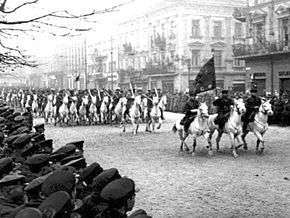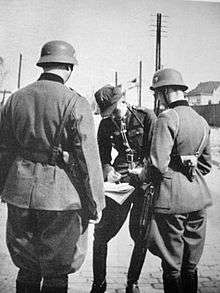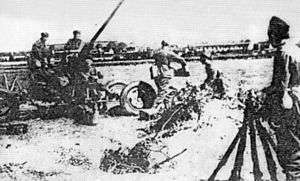Battle of Lwów (1939)
| ||||||||||||||||||||||||||||||
The Battle of Lwów (sometimes called the Siege of Lwów) was a World War II battle for the control over the Polish city of Lwów (now Lviv, Ukraine) between the Polish Army and the invading Wehrmacht and the Red Army. The city was seen as the key to the so-called Romanian Bridgehead and was defended at all cost.
First clashes

Initially, the town of Lwów was not to be defended as it was considered too deep behind the Polish lines and too important to Polish culture to be fought over in warfare.[1] However, the fast pace of the Nazi invasion and the almost complete disintegration of the Polish reserve Prusy Army after the Battle of Łódź resulted in the city being in danger of a German assault. On September 7, 1939, general Władysław Langner started to organise the defence of the city.[2] Initially the Polish forces were to defend the Bełżec — Rawa Ruska — Magierów line against the advancing German forces. General Rudolf Prich was given command of the Polish forces in the area and on September 11 he prepared a plan of defence of the area. The Polish units were to defend the line of the San river, with nests of resistance along the Żółkiew - Rawa Ruska - Janów (also called Yaniv or Ivano-Frankove) to the west of the river Wereszycą — Gródek Jagielloński line.[2]
The following day the first German motorised units under Colonel Ferdinand Schörner, 1st Mountain Division (Wehrmacht), arrived in the area. After capturing Sambor (66 kilometres from Lwów), Schörner ordered his units to break through the weak Polish defences and capture the city as soon as possible.[3]:79 The assault group was composed of two motorised infantry companies and a battery of 150 mm guns. The group outflanked the Polish defenders and reached the outskirts of the city, but then was bloodily repelled by the numerically inferior Polish defenders.[4] The Polish commander of the sector had only three infantry platoons and two 75 mm guns, but his forces were soon reinforced and held their positions until dawn. The same day command of the city's defence was passed to General Franciszek Sikorski, a World War I and Polish-Bolshevik War veteran.
The following day the main forces of Colonel Schörner arrived, and at 14.00 the Germans broke through to the city centre, but again were driven back after heavy city fighting with the infantry units formed of local volunteers and refugees. To strengthen the Polish defences, on September 13 General Kazimierz Sosnkowski left Lwów for Przemyśl and assumed command over a group of Polish units trying to break through the German lines and reinforce the city of Lwów.[5]
Schörner decided to fall back and encircle the city to await reinforcements. His forces achieved a limited success and captured the important suburb of Zboiska together with the surrounding hills. However, the Polish forces were now reinforced with units withdrawn from central Poland and new volunteer units formed within the city. In addition, the Polish 10th Motorised Brigade under Colonel Stanisław Maczek arrived and started heavy fighting to take back the suburb of Zboiska. The town was re-captured, but the surrounding hills remained in German hands. The hills gave a good overview of the city centre and Schörner placed his artillery there to shell the city. In addition, the city was almost constantly bombed by the Luftwaffe. Among the main targets for the German air force and artillery were prominent buildings such as churches, hospitals,[6] water plant and power plants.[2]
New enemy


On September 17, 1939, the Soviet Union declared all pacts with Poland null and void as the Polish state had ceased to exist, and joined Nazi Germany in the occupation of Polish territory.[3]:83 The forces of the 6th Red Army of the Ukrainian Front under Filipp Golikov crossed the border just east of Lwów and started a fast march towards the city. The Soviet invasion made all plans of the defence of the Romanian Bridgehead obsolete, and the Polish commander decided to withdraw all his units to the close perimeter and defend only the city itself instead of the whole area. This strengthened the Polish defences. On September 18 the Luftwaffe dropped thousands of leaflets over the city urging the Poles to surrender. However, this was ignored and a general assault was started on the city, once again to be repulsed.
The intervention of the Red Army on 17 September also made necessary some changes in the German plan of operations.
In the early morning of September 19, the first Soviet armoured units reached the eastern outskirts of the city and the suburb of Łyczaków. After a short fight, the Soviet units were pushed back. However, overnight the Soviet forces completed the encirclement of the city and linked with the German army besieging Lwów from the west.
The Polish defences were composed mainly of field fortifications and barricades constructed by the local residents under supervision of military engineers. General Sikorski ordered organised defence of the outer city rim, with in-depth defences prepared. In the morning of September 19, the first Soviet envoys arrived and began negotiations with the Polish officers. Colonel Ivanov, the commander of a tank brigade, told to Colonel Bronisław Rakowski that the Red Army entered Poland to help it fight the Nazis and that the top priority for his units was to enter the city of Lwów.
The same day Colonel Schörner sent his envoy and demanded the city be surrendered to his troops. When the Polish envoy replied that he had no intention of signing such a document, he was informed that a general assault was ordered for September 21 and the city would most surely be taken. The Hitler's evacuation order from September 20 instructed Rundstedt to leave the capture of Lwow to the Russians. The attack planned by XVIII Corps for 21 September was cancelled, and the German corps prepared to move to the west of Vistula-San River line. The following day, General Sikorski decided that the situation of his forces was hopeless. The reserves, human resources and materiel were plentiful, but further defence of the city would be fruitless and only result in more civilian casualties. He decided to start surrender talks with the Red Army.
Surrender

On September 22, 1939, the act of surrender was signed in the suburb of Winniki. The Red Army accepted all conditions proposed by general Władysław Langner. The privates and NCOs were to leave the city, register themselves at the Soviet authorities and be allowed to go home. Officers would be allowed to keep their belongings and leave Poland for whatever country would accept them. The Soviet forces entered the city and the Soviet occupation began. Unsurprisingly, the Soviets broke the terms of surrender signed that morning shortly after noon, when the NKVD began arresting all Polish officers. They were escorted to Tarnopol, where they were sent to various Gulags in Russia, mostly to the infamous camp in Starobielsk. Most of them, including general Franciszek Sikorski himself, would be murdered in what became known as the Katyn Massacre in 1940.[3]:84
Order of battle
The Polish defences were still not organised enough and consisted only of token forces. General Sikorski had approximately 11 infantry battalions, 5 batteries of artillery (mainly 75 mm guns), cavalry unit, engineering platoon and a small number of soldiers who retreated into the city. On 18 September two armoured trains: No.53 and No.55 (with two 100 mm howitzers and four 75 mm guns in total) broke through to the city from Kovel, and took part in further actions.[7]
The German units consisted of an entire 1st Mountain Division.
Polish
| Division or Brigade | Regiments | ||
| Southern Front Sosnkowski |
35th Infantry Division Szafran |
205th Infantry Regiment 206th Infantry Regiment 207th Infantry Regiment |
|
| 10th Motorized Cavalry Brigade Maczek |
10th Mounted Rifle Regiment 24th Uhlans Regiment | ||
| 11th Infantry Division Prugar-Ketling |
48th Rifle Regiment 49th Rifle Regiment 53rd Rifle Regiment | ||
| 24th Infantry Division Schwarzenberg-Czerny |
17th Infantry Regiment 38th Infantry Regiment 39th Infantry Regiment | ||
| 38th Infantry Division Wir-Konas |
96th Infantry Regiment 97th Infantry Regiment 98th Infantry Regiment | ||
German
| Corps | Division or Brigade | Regiments | |
| 14th Army List |
XVIII Corps Eugen Beyer |
1st Mountain Division Ludwig Kübler |
98th Jäger Regiment 99th Jäger Regiment 100th Jäger Regiment |
| 2nd Mountain Division Valentin Feurstein |
136th Jäger Regiment 137th Jäger Regiment 130rd Jäger Regiment | ||
| XVII Corps Werner Kienitz |
7th Infantry Division Eugen Ott |
19th Infantry Regiment 61st Infantry Regiment 62nd Infantry Regiment | |
Soviet
| Corps | Division or Brigade | Regiments or Battalions | |
| 6th Army Golikov |
2nd Cavalry Corps Kostenko |
3rd Cavalry Division Kotovsky |
34th Cavalry Regiment 60th Cavalry Regiment 99th Cavalry Regiment 158th Cavalry Regiment 44th Tank Regiment |
| 5th Cavalry Division Blinov |
11th Cavalry Regiment 96th Cavalry Regiment 131 Cavalry Regiment 160th Cavalry Regiment 32nd Tank Regiment | ||
| 24th Light Tank Brigade Fotchenkov |
101st Independent Tank Battalion 102nd Independent Tank Battalion 106th Independent Tank Battalion 117th Independent Tank Battalion | ||
| 17th Rifle Corps Kolganov |
10th Tank Brigade Ivanov |
51st Independent Tank Battalion 54th Independent Tank Battalion 57th Independent Tank Battalion 62nd Independent Tank Battalion | |
See also
References
- Inline
- ↑ Wacław Stachiewicz (1998). Wierności dochować żołnierskiej (in Polish). Warsaw, RYTM. p. 832. ISBN 83-86678-71-2.
- 1 2 3 Artur Leinwand (1991). "Obrona Lwowa we wrześniu 1939 roku" (in Polish). Instytut Lwowski., see also general reference No. 2
- 1 2 3 Zaloga, S.J., 2002, Poland 1939, Oxford: Osprey Publishing Ltd., ISBN 9781841764085
- ↑ Kazimierz Ryś (Kazimierz Ryziński); Ryszard Dalecki (1943–1990). Obrona Lwowa w roku 1939 (in Polish). Palestine-Rzeszów: WEiP APW, Krajowa Agencja Wydawnicza. p. 50. ISBN 83-03-03356-5.; ISBN refers to the 1990 reprint of the original publication
- ↑ Sosnkowski, Kazimierz (1988) [London 1943], Rzepniewski, Andrzej, ed., Cieniom września (in Polish) (I ed.), Warsaw: Wydawnictwo MON, p. 289, ISBN 83-11-07627-8
- ↑ Wojciech Włodarkiewicz (2003). Lwów 1939 (in Polish). Warsaw: Bellona. p. 273. ISBN 83-11-09619-8.
- ↑ Rajmund Szubański (2004), Polska broń pancerna 1939, Warsaw, ISBN 978-83-11-10031-2, p.267-268 (Polish)
- General
- various authors; Komisja Historyczna Polskiego Sztabu Głównego w Londynie (corporate author) (1986). Polskie siły zbrojne w drugiej wojnie światowej; Vol. 1 parts III and IV (in Polish). London: Instytut Polski i Muzeum im. Gen. Sikorskiego. p. 606.
- collection of documents (1997). Artur Leinwand, ed. Dokumenty obrony Lwowa 1939 (in Polish). Warsaw: Instytut Lwowski. p. 281. ISBN 83-910659-0-1.
- Further reading
- various authors. Janusz Wojtycza, ed. Wspomnienia harcerzy - uczestników obrony Lwowa we wrześniu 1939 roku (in Polish). Kraków: Towarzystwo Sympatyków Historii. p. 196. ISBN 83-912784-7-6.
- Władysław Langner (1979). Ostatnie dni obrony Lwowa 1939 (in Polish). Warsaw: BH (samizdat). p. 23.
- Wojciech Włodarkiewicz (1996). Obrona Lwowa 1939 (in Polish). Warsaw: Bellona. p. 117. ISBN 83-11-08263-4.

